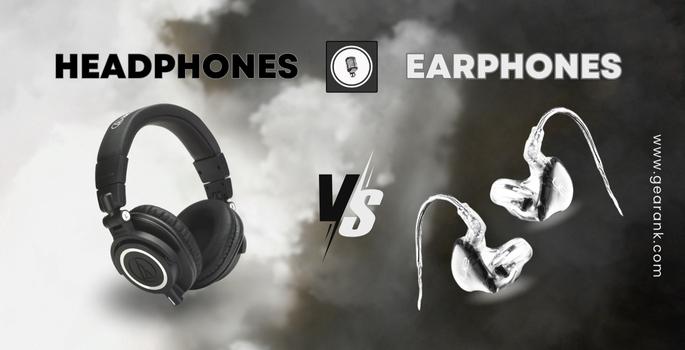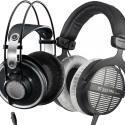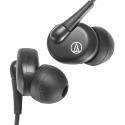Headphones vs Earphones: A Pro Audio Perspective

Headphones and earphones, despite their different form factors, are terms often thrown around interchangeably.
A handful of headphones and earphones are on the market and look similar. Using the wrong headphones or earphones for music production and live sound can set you back. So it's essential to understand the differences between headphones vs earphones and the details in between.
I will run through the different headphones and earphones in this guide. We will review their advantages and disadvantages and which ones you should use for music production.
Table of contents
-
Headphones vs Earphones: Consumer or Pro Audio?
-
The Different Types of Headphones
-
Closed Back and Open Back Headphones
-
The Benefits and Drawbacks of Open-Back Headphones
-
The Benefits and Drawbacks of Closed-Back Headphones
-
The Different Types of Earphones (In-Ear vs Earbuds)
-
Comparing Headphones vs Earphones - The Key Differences
-
Earphones vs Headphones - Which Sound Better?
-
Are earphones vs. headphones for live sound and music production?
-
Can You Use Earphones for Music Production?
-
IEMs for Music Production
-
Studio Monitors vs Headphones for Music Production?
-
Final Thoughts
Headphones vs Earphones: Consumer or Pro Audio?
Depending on use, both earphones and headphones can be divided into two categories: consumer and pro audio.
Consumer-grade headphones and earphones are designed for daily use and private listening. It seeks to maximize the overall listening experience of the consumer using average audio devices. Consumer-grade earphones and headphones enhance the sonic profile of a track's bass and treble frequencies. Tracks played on these are meant to sound great in general.
There are a different set of factors when choosing between earbuds vs headphones for a consumer audio device. Aside from good sound quality, you have to factor in compatibility, mobility, style, comfort, active or passive noise isolation, and more. This is why the headphones vs earbuds debate is a bit more complex in the consumer audio arena. And this is also the reason why true wireless earbuds are dominating the consumer earbuds versus headphones market.
Pro audio headphones and earphones are tailor-made for studio and live sound applications. They have neutral or flat frequency response and better dynamic range. These headphones and earphones are not meant to make your mixes "sound good." They are intended to reveal the finer details and flaws of the mix, which allows for better mixing decisions resulting in better sound quality.
Mixing scenarios have to reflect the sound as it is without any further boosts or enhancements. It gives sound engineers an unaltered point of reference to balance and mix the tracks.
In the coming sections, I will refer to them as monitor headphones or in-ear monitors.
The Different Types of Headphones
Headphones are worn over the head (over or on the ears). Conversely, earphones rest on or in the ear canal and come in various designs for different listening purposes. These include:
-
Closed back headphones
-
Open back headphones
-
Over-ear headphones
-
On-ear headphones
All the headphones mentioned here can be wired and wireless headphones. The only exception is the open back.
Over-ear and on-ear headphones are quite similar but different regarding sound isolation. Over-ear headphones have a larger ear cup diameter. They create a secure seal for sound isolation and passive noise cancelling. On-ear headphones have a smaller cup diameter and rest on the ears. On-ear headphones have a compact design for people who prefer smaller-sized headphones.
For music production, the headphones that you should be looking for are monitor headphones. They are used for tracking and mixing in the studio or live. Specifically, these over-ear monitor headphones are open-back and closed-back headphones and semi-open-back headphones.
Closed Back and Open Back Headphones
Closed-back headphones have a closed form factor that doesn't let air pass. This means they offer superior noise cancellation via passive isolation--outside noise and sounds get blocked out. This type is recommended if you're looking for immersive sound quality. On the flip-side, closed-back headphones can introduce low-frequency build-up due to their enclosure. This can compromise the accuracy of mixing instruments with much low-frequency content. In addition, it can cause some ear fatigue in longer sessions.
Open-back headphones tend to let air pass through and, in turn, reduce low-frequency accumulation. The sound pressure doesn't travel only in one direction and gets released outside the headphones. Due to this, it tends to sound more natural and transparent. It minimizes the general discomfort of long mixing sessions as well.
That said, semi-open-back headphones are a blend of both designs. They allow the airflow to pass through while reaping the benefits of sound isolation.
Closed and open-back headphones are utilized interchangeably during long listening sessions. Regardless of whether it's for music production and easy listening, choosing among the best headphone brands has proven to be the most reliable route when selecting the right one.
The Benefits and Drawbacks of Open-Back Headphones
The Benefits:
-
Deliver sound that is more accurate and realistic.
-
They are more lightweight than closed-backs, which makes them comfortable to wear.
-
Conducive for long listening sessions and critical listening in quiet environments.
-
Reduced possibility of earache due to its open design.
The Drawbacks:
-
Little to no sound isolation.
-
Ambient noise can hinder listening when mixing in a busy environment.
-
Reduced private listening experience.
-
Sound leakage in recording sessions.
The Benefits and Drawbacks of Closed-Back Headphones
The Benefits:
-
Reduced ambient noise.
-
Sound isolation allows you to mix outside the studio.
-
Suitable for tracking audio in recording sessions.
-
Private listening, since the closed design also helps to prevent sound from escaping.
The Drawbacks:
-
Low-frequency build-up due to its closed design.
-
A bit heavier than closed-back headphones.
-
Can fatigue the ears quicker during long mixing sessions.
-
It can be uncomfortable during long listening sessions. The closed design reduces air and causes low frequencies to build up and resonate in the ears.
The Different Types of Earphones (In-Ear vs Earbuds)
The main types of earphones include:
-
Intra-concha earphones
-
In-ear (also commonly called earbuds)
-
In-ear monitors
What's worth mentioning here is that these earphone types and the terms used to define them often get mixed up and used interchangeably.
The main difference between them is that intra-concha earphones rest loosely in the concha bowls of the outer ear. In-ear headphones (in-ear earphones) and earbuds are inserted into the ear canal. It comes with a tighter seal and fit, sometimes with the addition of ear hooks.
All earphones, and most wireless earbuds are generally used for casual listening. As such features such as battery life and comfort take priority over audio quality.
The only exception when comparing earbuds is in-ear monitors. This type of earphone is used in live music performances and studio recordings. In-ear monitors or in-ear earbuds are built with more sophisticated drivers.
Individual frequencies of a signal are split depending on the number of drivers you have. An entry-level IEM has 2-3 drivers. The more drivers you have, the more accurate the sound mimics the original signal.
Comparing Headphones vs Earphones - The Key Differences
The most significant difference between headphones and earphones is the size and design. They also differ in sound and price, but this largely depends on the quality of the headphones and earphones.
Those aside, however, the critical differences between earphones and headphones are:
-
Headphones go over the head and either rest on or cover the ears. Earphones rest outside or inside the ears and ear canal.
-
Headphones have bigger and heavier components, and driver sizes are around 20mm to 50mm. Earphones are lighter, compact, and more portable- driver size is approximately 8mm to 15mm.
-
Headphones can be closed or open back. Most modern earphones—in-ear headphones and earbuds are "closed."
-
Headphones, especially studio headphones, are designed for listening accuracy of any audio source. Earphones are typically designed for great sound quality.
-
Headphones are intended for critical listening, such as music production and recording. Earphones are more for casual listening at home or for outside listening.
Earphones vs Headphones - Which Sound Better?
So which offers better sound quality, headphones or earphones?
Both headphones and earbuds can sound "good," especially if they are premium headphones or earphones of the same price point. Personal preference also plays a role in what counts as "good." Despite this, some general observations can be drawn when comparing the two.
Their form factor affects the way sound interacts with our ears. Headphones generally have better bass response, regardless of whether they're consumer or pro audio. They have more space for bigger drivers and a more nuanced frequency response. Dynamic range and stereo image are also more accurately reproduced in headphones than in earphones.
For a casual listening experience, many wireless earbuds tend to have a bass boost and a combination of passive noise cancellation and active noise cancellation. These are used to compensate for earphones' perceived loudness.
For music production and live sound, a good pair of monitor headphones will provide a transparent, more natural sound with improved audio signal frequency accuracy, plus the option of closed-back or open-back designs.
Earphones vs Headphones for Live Sound and Music Production?
Monitor headphones are used for studio recording and mixing. Earphones, specifically IEMs (in-ear monitors), monitor, mix, and track live performances.
Monitor headphones provide a flat response and don't add sound coloration to the song like consumer headphones. A flat frequency response makes it easy to make mixing decisions that can result in good sound quality across different speakers, headphones, and earphones.
IEMs are used live by performers as a better alternative to monitor speakers where they can hear the sound directly being fed to their ears. Live sound engineers would also use IEMs as an additional reference for fine-tuning the mix. IEMs also allow for customization where a mold is fed through the ear canals for immersive sound isolation.
Can You Use Earphones for Music Production?
The use of earphones for mixing has been an ongoing discussion among sound engineers. Some suggest that you mix in studio monitors and headphones. Others suggest that you can mix with earphones, but you have to know how they color the sound so you can adjust accordingly.
A better approach would be a blend of both. Use monitor headphones or speakers first. Then, test out your mixes in earphones as a reference.
Minor tweaks and calibrations on regular earbuds and headphones help achieve that consistent sound quality. The challenge is, again, knowing how the earphones color the sound.
IEMs for Music Production
IEMs are slowly becoming popular as an alternative to monitor headphones. While they're predominantly used for live sound, some in-ear monitors can be used for studio purposes. One example is the Ultimate Ears IEMs for mixing and mastering.
Studio Monitors vs Headphones for Music Production?
Studio monitors and headphones are both critical for music production. Studio monitors are used in the mixing room, while headphones and IEMs are used in the recording booth.
In terms of mixing and mastering, both are designed to have a flat frequency response. However, studio monitors provide a much more accurate and natural sound reproduction.
These speakers have the benefit of traveling naturally through space. Stereo-imaging panning and effects such as reverb are better represented than using headphones. The glaring downside? Its efficacy is highly dependent on how acoustically-treated your environment is.
In rooms with poor acoustic treatments, headphones can supplement studio monitors. Headphones can be used to fine-tune sounds that you may have missed on your studio monitors.
It is also certainly possible to mix exclusively with headphones. However, assessing the sonic content of your mixes takes a good amount of skill. Mixing in headphones is difficult because the sound is fed directly to your ear canals. This can create the illusion that some frequencies are louder than others due to their enclosure.
That being said, studio and headphone monitors are indispensable in music production. Studio monitors are for home studio use. For on-the-go use, a pair of studio headphones is essential for better sound isolation.
Final Thoughts
While there's a preferential aspect to choosing headphones vs earphones, there are guidelines for selecting the appropriate headphones. For recording and mixing music and live sound, studio monitor headphones and in-ear monitors will represent sound much more effectively. Premium headphones for studio use are not designed to "sound good." They offer numerous benefits for critical listening purposes, including better sound accuracy in terms of dynamic range and flat frequency response.
Contributors:
- Allen Articulo - Co-writer
- Jerry Borillo - Illustrator












